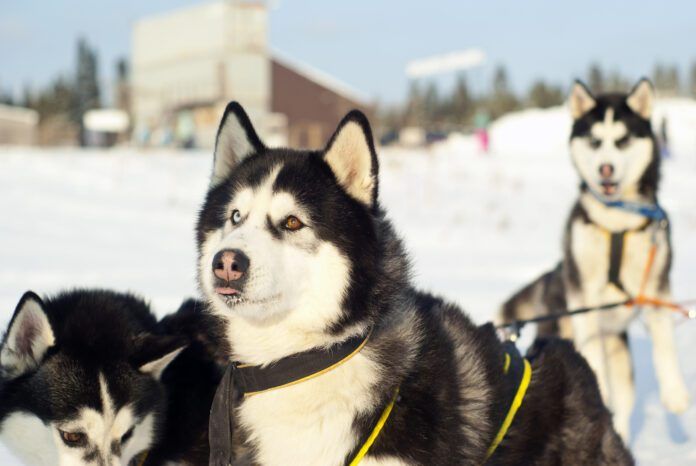Is your dog’s normally dark colored nose turning pink or tan? If it’s winter, and everything else about your dog is normal, this discoloration on a dog’s nose is likely a benign phenomenon called snow nose or Dudley nose. It is a seasonal loss of pigment in the nose, thought to be genetically linked to liver-colored noses. It can involve the whole nose, just a center stripe, or come in random patches. Dog breeds that commonly get snow nose include Siberian Huskies, Malamutes, American Eskimos, Golden Retrievers, Labrador Retrievers, Bernese Mountain Dogs, and Cocker Spaniels.
Nobody knows for sure why it happens, but it is thought to be associated with shorter daylight length and lack of sunlight that results in decreased melanin production. Melanin is the pigment in skin that makes you look tan in the summer. Many dogs, although not all, regain their darker nose color in the spring and summer. Some experts think this aspect of the syndrome may simply be due to the direct tanning effect of UV rays. Either way, your dog’s nose color will likely cycle with the seasons.
How to be sure it’s just snow nose and not something worse? Snow nose is just a color change, basically fading from dark to beige or pink. There are no other changes to the surface appearance, texture, or architecture of the nose, and the dog is not bothered by it.
If your dog’s nose has raised lesions or bumps; ulcerated or raw areas; crusting, scaling, scabbing or bleeding; or it seems uncomfortable, then it’s time to get to the vet. These symptoms do not happen with snow nose. They are more likely to be indicative of autoimmune disease, infectious disease, or cancer.
Snow nose has no known treatment or prevention. Some people have tried vitamin E (an antioxidant which stabilizes cell membranes so may slow down depigmentation) and kelp supplementation (high in iodine to aid thyroid hormone production, which is involved in the pigmentation process) has been suggested, although neither of these are likely to make a difference. The best thing you can do for your dog’s snow nose is to apply sunscreen to protect it, especially when it’s pink.
Look for a sunscreen made specifically for dogs. They are available as lotions, sprays, sticks, balms, ointments, and clothing. Look for a product that matches your dog’s lifestyle. Some must be applied 15 to 20 minutes before sun exposure, while others offer instant protection. Waterproof products may best suit swimming dogs.
Dog-safe sunscreens do not contain zinc oxide or para-aminobenzoic acid (PABA), which are commonly found in human sunscreens and are toxic to dogs. If your dog has sensitive skin, test new products for allergic reactions by applying sunscreen to a small area of bare skin. Check it after 24 to 48 hours for signs of irritation and if it causes a reaction, try a different product.






